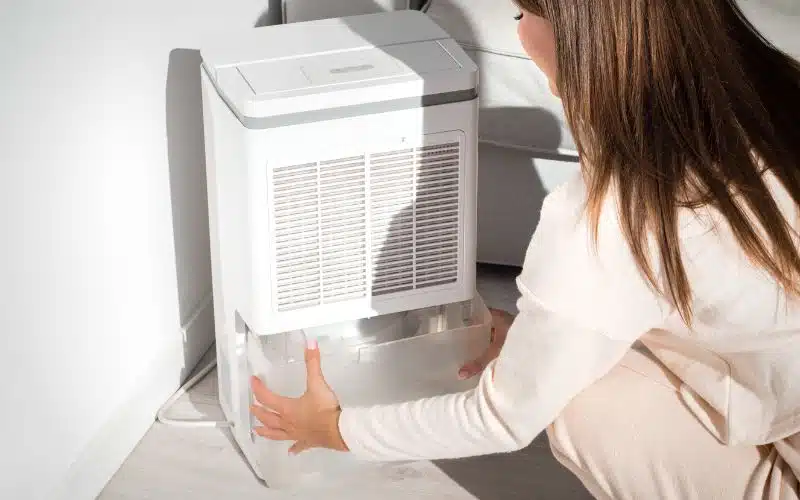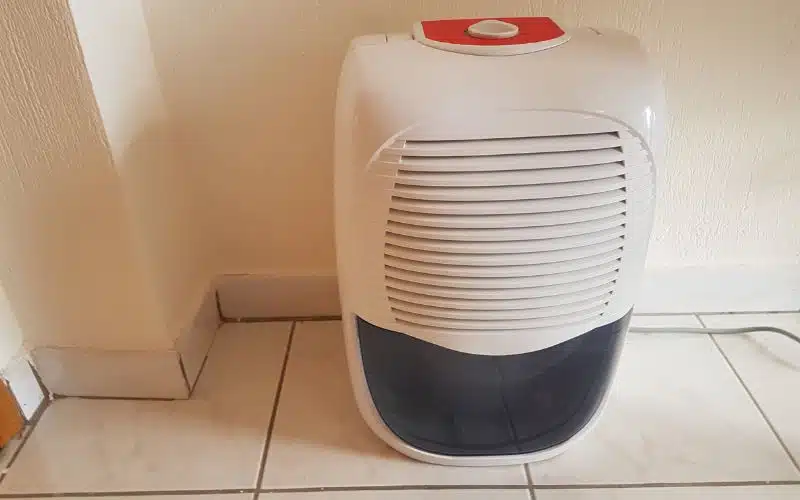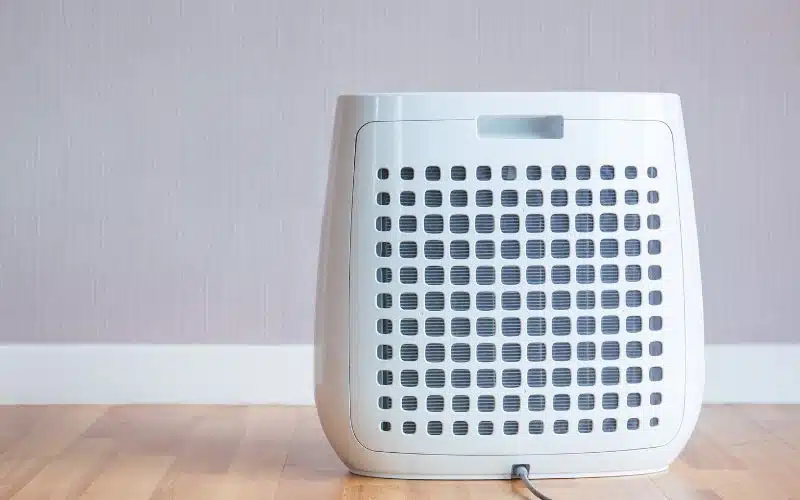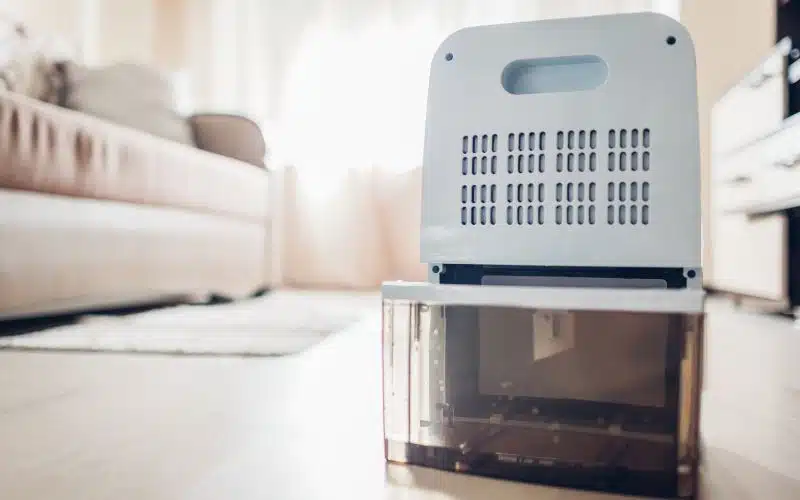Hisense dehumidifiers have internal buckets used to store condensate collected from the air. The sizes of internal buckets range from 10 up to 70 pints.
You can drain the bucket manually or install a hose to the dehumidifier to automatically drain the water elsewhere.
But you may wonder how to attach a hose to a Hisense dehumidifier. You’ll find out shortly.
You can attach a hose to your Hisense dehumidifier by opening the port on the sides or back of the unit and plugging it in. The plugging location depends on whether your model has an electric pump or uses gravity assist. For dehumidifiers without a pump, plug into the side, but for those with a pump, plug at the rear.
In this article, I will take you through the step-by-step process of attaching a hose to your Hisense dehumidifier, whether pump-driven or gravity-assisted.
5 Steps to Attach a Hose to Your Hisense Dehumidifier

You can attach a hose to your Hisense dehumidifier through a straightforward process that makes draining water easy.
A hose allows the dehumidifier to have continuous drainage, canceling the need to empty the water bucket regularly.
Let’s see the steps needed to attach a hose to your Hisense dehumidifier.
#1. Identify your Dehumidifier Model
The first thing you should do before attaching a drain hose to your dehumidifier is to identify the model to know if it is a pump or a manual drain.
Small-size dehumidifiers, especially those under 50 pints, are usually manually drained, while larger capacity models have a pump.
Identifying the type of dehumidifier you have will help you locate where its drain hose port is.
Manually drained dehumidifiers have their drain port at the unit’s sides. Raising a cover at the middle sides of the dehumidifier will expose the port.
Pump-driven dehumidifiers have their drain ports located at the back of the unit. Lifting a cover at the back of the panel exposes the drain port.
#2. Get the Correct Hose Size
You can purchase the correct drain hose after identifying and locating the drain port. Hisense uses standard North American drain hose sizes of ¾ diameter straight thread.
Their dehumidifiers might not ship with a hose, so you must purchase one elsewhere. There are a variety of dehumidifier hoses online, and you can purchase one here.
- [Convenient] This drain hose automatically drains...
- [Functionality] The Dehumidifier Drain Hose...
- [Extended functions] The other end of the hose...
- [PVC material] Made of high quality PVC material,...
Last update on 2024-01-05 / Affiliate links / Images from Amazon Product Advertising API
You should also ensure to buy a drain hose with sufficient length to reach the drain or external storage tank.
#3. Plug in the Hose
If you have purchased the correct drain hose and exposed the drain port, you can now plug the hose.
As mentioned, the drain ports are on the sides for manual dehumidifiers and the rear for pump dehumidifiers.
You must connect the hose’s female port to the dehumidifier’s male port and tighten it to prevent leaks.
After doing this, you can test the hose to see if leaks are in the hose connection. Reinstall the hose if you detect any leak in the connection.
#4. Perform Drain and Dehumidifier Placement
Connecting the hose to the dehumidifier is not the end; you must find where to drain the water.
Pump-driven drain dehumidifiers can pump water into drains or out through a window in the room. In contrast, manual models must drain into a sink or tub.
Dehumidifiers with pump drains are easier to place because they can pump water into a drain regardless of location.
Place the dehumidifier on the ground near a window or drain and pass the drain pipe through it to ensure the water goes out.
For manual drain dehumidifiers, you should place the dehumidifier on top of a high and flat surface so gravity can drain the water.
#5. Run the Dehumidifier
The last and final step is to run the dehumidifier and observe how well it drains and if the pump works.
If you use an automatic model, the pump should activate whenever the water in the bucket reaches a certain level.
The pump should run for a few seconds and reduce the water in the bucket. You should note that some water will still be in the bucket, so try not to spill.
Manual pumps drain water from the unit when it reaches a certain level, but it won’t be as fast as the pump.
Gravity assist draining might not be the fastest, but it is one of the most reliable and cheapest methods to set up.
Can you use a Garden Hose to Drain your Hisense Dehumidifier?
Yes, you can use a garden hose to drain your Hisense dehumidifier, granted the hose is the correct size and has a suitable female connector.
There are three ways you can drain your Hisense dehumidifier, which are
- Manual draining
- Gravity assisted drainage
- Pump draining
Besides the manual setup, gravity assist and pump draining require a garden hose. You can get one from a shop near you or purchase it online.
The garden hose can go into a wall-mounted sink, window, or floor drain. The water can drain out the window for pump dehumidifiers or into a drain for manual units.
Here is a table comparing the differences between the three methods of draining Hisense dehumidifiers.
| Manual Draining | Gravity Assist Draining | Pump Driven Draining |
|---|---|---|
| The inner bucket is emptied by hand when it is full. | The water drains continuously through the hose. | The inbuilt pump drains the inner bucket when the water reaches a certain level. |
| It doesn’t need to be near a sink or drain. | It needs to be near a sink or drain below its CG. | The dehumidifier can be located away from the drain or sink. |
| Requires frequent manual labor. | It requires weekly bucket cleaning. | It only requires weekly bucket cleaning. |
| It doesn’t require any extra setup cost. | Requires you to purchase a garden hose. | You have to buy a garden hose. |
Can you Attach a Hose and Drain bucket to a Hisense Dehumidifier?
Yes, you can attach a drain and a hose to your Hisense dehumidifier, but you have to satisfy a few requirements before you can do so.
Attaching a hose to a Hisense dehumidifier is quite easy if you know how to set it up. If you run your dehumidifier unit continuously, install a hose to drain any condensate.
Small-sized dehumidifiers are especially tedious because they fill up quickly and need frequent dumping.
Irrespective of your dehumidifier size or model, you can still install a hose and a bucket to drain water from it.
Here are some requirements for attaching a hose and a drain bucket to a Hisense dehumidifier.
#1. Identify your Dehumidifier
Depending on your dehumidifier model, you can drain water with a hose.
Dehumidifiers without a drain pump use gravitational potential to drain water. While models with a pump, pump the water away.
Automatic drains are more convenient in the long run but might be hard to set up.
One of the advantages of automatic pumps is that you can pump water upwards into a drain or out a window.
It makes locating it easy, but you can’t do the same for manual models.
#2. Locate the Drain position.
Depending on your dehumidifier model and where the drain is, you can drain into a floor drain or through windows.
Kitchens, laundry rooms, basements, and bathrooms are some of the rooms in the home that usually have drains or sinks installed.
These rooms coincidentally have the highest ambient humidity of all other rooms so you can locate your dehumidifier there.
You can place the dehumidifier on the floor or a raised platform like a slab and connect the hose to a drain or sink. You can use this method for the kitchen and bathroom with sinks.
Laundry rooms and basements usually have plumbing for washing machines. You can drain the dehumidifier into the washer drain.
#3. Set the Dehumidifier Position
Dehumidifiers do not perform well when placed against a wall or somewhere that restricts their airflow.
Finding a balance between ventilation and a dehumidifier drain position is important. If ventilation becomes an issue, try adjusting the dehumidifier’s location around the drainage.
You can try other methods, like increasing the length of the drain hose to reach the drain from any part of the room. It isn’t advisable to extend the hose if your unit isn’t pump-powered.
If your unit uses gravity to drain the inner bucket, you must ensure the drain lies below the center of gravity of the dehumidifier.
Does a Manual Hisense Dehumidifier need a Hose Drain?
Yes, you can choose to install a hose drain on your manual dehumidifier unit.
Manual dehumidifiers can use a hose to drain water from the dehumidifier, with a phenomenon called gravity-assist draining.
If you install a hose drain to your manual Hisense dehumidifier, the water will flow outside when it reaches a certain level reducing the need to empty the inner bucket daily.
In other words, you can run your dehumidifier continuously every day, only stopping to clean the inner bucket if you install a hose drain.






